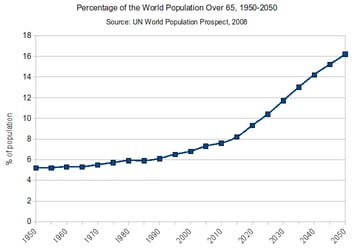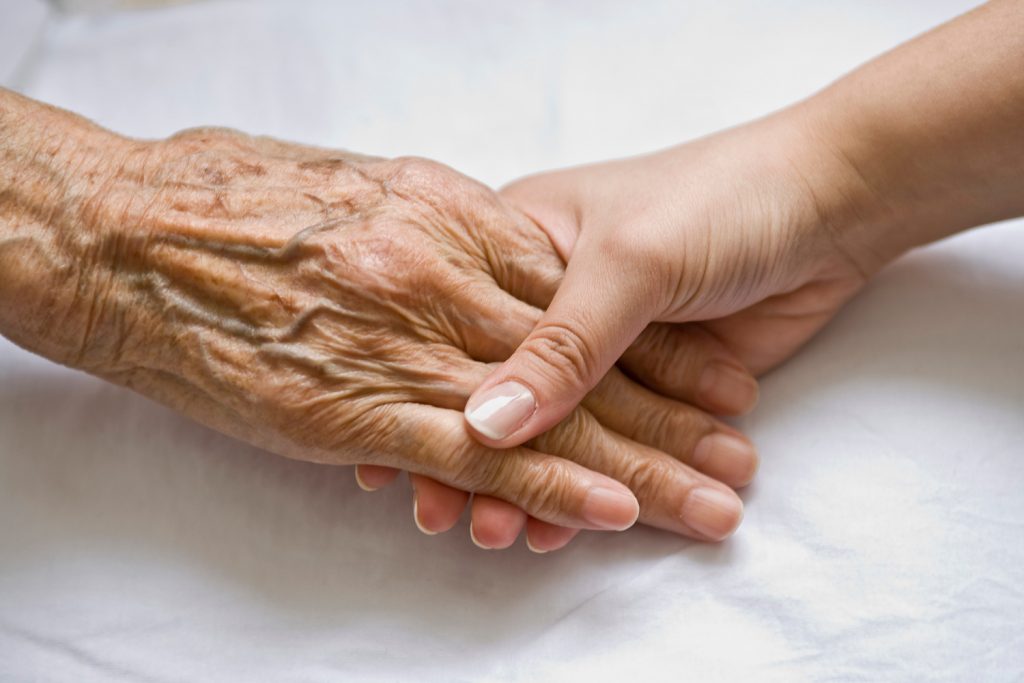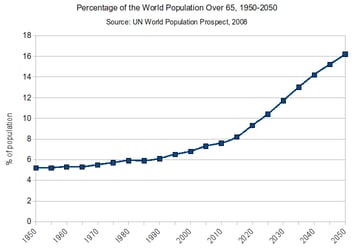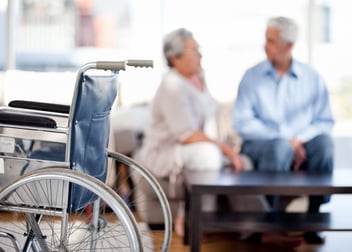Did you know that the aged population is at its highest level in all of human history? Here are 6 ways technology can help us deal with aging populations.
Did you know that the aged population is at its highest level in all of human history? During the 21st century, we’re going to see faster aging than ever. This is not a temporary change, according to an extensive study done by the UN. The study examined how the world population has aged and will continue to age from 1950 to 2050. This is a global phenomenon and will affect people in every single country.
Aging populations come with a unique set of economic and social challenges, and countries around the world need to find ways to face these challenges. A study by IBM found some sobering statistics, such as that 3 in 5 seniors deal with a long-term physical condition, while 1 in 3 has a short-term one. 1 in 4 suffer from memory problems.
 In addition to these health concerns, demographic shifts mean that the ratio of caregivers to individuals is decreasing; there are fewer and fewer people available to help elders.
In addition to these health concerns, demographic shifts mean that the ratio of caregivers to individuals is decreasing; there are fewer and fewer people available to help elders.
Faced with this situation worldwide, it’s essential to develop new ways to help our aging populations.
Technological advances can provide many tools that can help us to combat common problems that seniors encounter. If we can match technology with seniors’ needs and wants, we can improve their lives and help society as a whole. Here are six ways we can use technology to help aging populations - and many of them are already happening.
Are you interested in how we can use technology to help our aging populations? Join our “Big Data Saves Lives” group on LinkedIn to participate in the discussion.
 1. Identify at-risk individuals early on
1. Identify at-risk individuals early on
Currently, many social services organizations use a reactive model to help people - i.e. someone must make the organization aware that an individual needs help. However, this model means help can only go to those who are both capable of asking for help and aware that they are eligible for assistance. There are many people at risk who don’t meet these conditions.
Using Big Data, we can shift to a predictive model of helping people instead. Data can be used to predict which people are likely to be at risk, and social services can proactively contact them. Not only can organizations reach individuals who wouldn’t otherwise have gotten assistance, but they can also provide more timely interventions.
 2. Help seniors be more self-sufficient
2. Help seniors be more self-sufficient
90% of seniors in the U.S. expressed a desire to live in their own homes as long as they can. Technology makes this possible. Even if they don’t have serious health problems, many elderly people suffer from mobility issues, and so may find it difficult to do something simple like getting up to turn a light on. But with Internet of Things technology, we can provide people with simple tools to make a small but meaningful difference in their lives.
Let’s talk about some small changes you could make to a senior’s house. Maybe they could open a door using a mobile device. Perhaps the sink could have a sensor to turn on or off, or the stove could shut itself off if it’s been on for too long. Or lights could come on automatically when motion is detected. This could help prevent falls when a person gets up in the middle of the night.
This information can also be made accessible to a family member or caregiver, who can monitor the situation and be aware of changes.
All of these small shifts can help individuals maintain a level of self-sufficiency they wouldn’t otherwise have.
3. Bring medical care into their own homes
For elderly people, a trip to the doctor to get much-needed care can be a big undertaking. Rather than having them making a difficult trip, technology can help us bring doctors to them in their own homes. An article in Forbes estimates that 22 million households will use some form of virtual care by next year.
Many medical centers offer telehealth services, meaning that patients can contact doctors either by phone or via video calls. Technology-based care can also take the form of facial-scanning technology and questionnaires that help to diagnose a patient (like our own Medic Mirror).
There are also tools that can take on the role of a carer, doing things like helping seniors to remember things and make decisions. IBM’s Cognitive Eldercare tool and our Voice Helper are just two of these tools. The Voice Helper can send out programmed reminders to take medication, for example.
The tools can also be used to track health patterns. It’s helpful for a carer or family member to be able to see changes in health patterns. It’s also a way to keep the individual actively participating in their own healthcare.
4. Protect them from fraud
Aging populations are vulnerable to financial fraud and identity theft. The National Center on Elder Abuse reports that 1 out of every 8 cases they receive is related to financial exploitation. Fortunately, banks are already taking increased security measures to protect seniors from theft, with things like fraud detection systems. Virtual wallets specially designed for seniors are also a possibility.
Banks can also collect data on how aging populations behave so as to improve how they detect suspicious behavior.
There’s also one low-tech measure caregivers can take to help protect seniors - simply discuss financial information with them. Here, technology can play a role by helping seniors keep in touch with a loved one or professional advisor.
5. Keep them feeling like part of a community
A study by the University of California, San Francisco, found that 43% of seniors feel lonely on a regular basis. Seniors who reported feeling lonely had a 59% greater risk of decline, and a 45% greater risk of death. This is a serious problem, and we must develop technological tools to keep over-65s engaged in their communities.
Video chatting apps and social media can help seniors stay in touch with loved ones. Things like virtual reality - say, tours of art museums or a trip to a historic landmark - can connect them to their past memories to reminisce, and there are plenty of cognitive games online that can help keep them mentally sharp.
We’re even seeing the emergence of virtual senior centers where older adults can connect to socialize, as well as take classes to learn new skills. Even though they may not be able to leave home often, they can still feel involved and like part of a community.
The key is making the solutions specifically tailored to the senior population. We must also make sure the benefits are clear to seniors. Small details like having a simple interface and a big enough font can go a long way to making them engage with the technology.

6. Identify problems before they become a full-blown crisis
One common thread running through the five above examples is that data can help identify a problem before it becomes a crisis. We can establish patterns more easily, and spot changes earlier on than without data. When data starts to look a bit different from normal, caregivers can reach out to intervene early on.
This can help deal with problems effectively, and at stages when they’re relatively manageable. It can also take some of the burden off of caregivers. They can rest assured that their loved one is monitored around the clock.
These technological tools are not only better at spotting inconsistencies or changes than humans are, but they are often more affordable and faster, too. This is not to say that people are irrelevant. Rather, we can use data to supplement what we do well and dramatically improve how we care for our aging populations.
Further reading:
Join our “Big Data Saves Lives” group on LinkedIn to participate in the discussion and share your insights. Feel free to invite your colleagues to the conversation, too.




